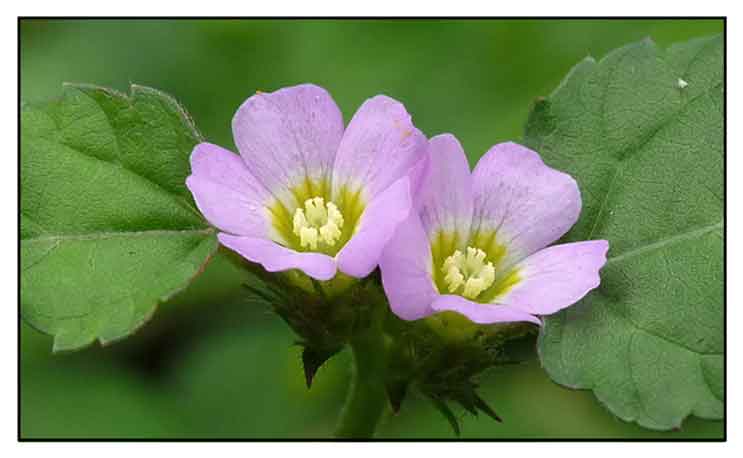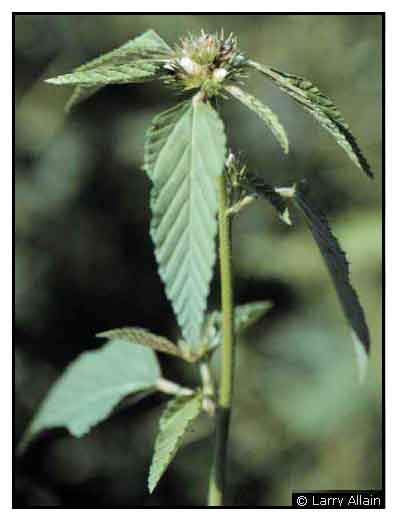
Botany
Bankalanan is an erect or spreading, branched, half-woody shrub, usually less than 1 meter high. Leaves are oblong-ovate, and 2 to 6 centimeters long, with pointed tip and broad, rounded, or heart-shaped base. Flowers are somewhat crowded in terminal or axillary heads. Petals are obovate, white, pink or pale purple, and about 7 millimeters long. Fruit is a small capsule, depressed-globose, 4 to 5 millimeters in diameter, green, whitish or pink to purplish black. Cells are 1-2 seeded. Seeds and small and wingless. Endosperm is abundant.
Distribution
- A weed common in waste places, open grasslands, fallow fields, settled areas, etc., at low and medium altitudes throughout the Philippines
- Pantropic.
- Prevalent in tropical areas of Africa, Asia, and Australia.
- Reported in Peninsular Malaysia
- Common in the southeastern regions of the United States.
 Constituents Constituents
- Study isolated a cyclopeptide alkaloid, franganine, and a pseudooxindole alkaloid, melochicorine. (2)
-
Phytochemical screening of leaves of M. corchorifolia yielded triterpenes (friedelin, friedelinol, and ß-amyrin), flavonol glycosides (hibifolin, triflin, and melocorin), aliphatic compounds, flavonoids (vitexin and robunin), ß-D-sitosterol and its stearate,-D-glucoside, and alkaloids.
- Study yielded adouetine and a new cyclopeptide alkaloid, melofoline.
- Study isolated a cyclopeptide alkaloid, franganine, and a new pseudooxindole alkaloid, melochicorine.
- A glycoside, melocorin, was isolated from the leaves of M. corchorifolia along with hibifolin and trifolin.
- Phytochemical screening of methanol extract of aerial parts yielded alkaloids, terpenoids, steroids, phenolic compounds, flavanoids, and glycosides. (12)
- Proximate composition of leaves (DW basis) were crude lipid (13.33±2.89%), ash (10.00±0.10%), crude fiber (23.33±2.89%).and available carbohydrate (30.03±2.83%). Mineral composition in mg/100 g DW were: K(7.250±37.50), Ca (750.37 ±10.58), Mg (108.33±5.77) and P (101.89±0.08), Na (95.00—1.15), Cu (33.50±2.55), Fe (19.91±3.01), Mn (9.68±0.59) and Zn (6.73—0.62). (15)
Properties
- Studies have shown antifungal, antibacterial, antioxidant, insecticidal, hepatoprotective, insecticidal, anti-inflammatory properties.
Parts used
Leaves, roots, stems, sap.
Uses
Edibility / Culinary
- Consumed as a potherb in West Africa and Southern Africa.
- Leaves eaten in northern India and Annam.
- Leaves are cooked into a popular, slimy side-dish in Malawi.
Folkloric
- Leaves used for poulticing sores.
- Roots and leaves used for snakebites.
- Sap used for wounds poisoned by Antiaris.
- Leaves used for poulticing swellings of the abdomen and the heart.
- Leaves and roots used for poulticing in small pox.
- Decoction of roots and leaves used for dysentery.
- Simple leaf decoction used to stop vomiting; compound decoction, with Millettia and Celosia, used for urinary troubles.
- Plant is used to relieve gastralgia and headaches.
- In Tamil Nadu, India, decoction of leaves taken orally twice daily on an empty stomach for dysentery. (10)
- In India, leaves and roots used for treatment of urinary tract disorders, abdominal swelling, dysentery, and snakebites. (12)
- In coastal East Africa, leaves used for stomach disorders. In Benin seeds used to treat stomach aches.
- In Malaysia, leaves are used for poulticing sores and swelling of the abdomen. Sap applied as antidote to wounds caused by arrows poisoned with Antiaris toxicaria. (13)
- Leaves and roots used for poulticing in small pox. (13)
- In Sri Lanka ayurveda, leaves used in the treatment of intestinal bowel syndrome, diabetes mellitus. (15)
Others
- Fiber: Source of a strong fiber; used for making dillybags. (17)
- Crafts:
Stems used for tying bundles,and construction of roofs. (17).
Studies
• Flavonoids / Antifungal: Aerial parts of M. corchorifolia yielded 5,7-dihydroxyflavone, apigenin, kaempferol and quercetin. The flavonoids exhibited significant antifungal activity.
• Antifeedant / Insecticidal / Ovicidal: Study evaluated the antifeedant, insecticidal, oviposition deterrent and ovicidal activity of different fractions obtained from the crude extracts M. corchorifolia against the armyworm, Spodoptera litura. MC showed feeding deterrent activity and significant ovicidal and larvicidal activity. (3)
• Hepatoprotective / Antioxidant / Aerial Parts: Study evaluated extracts of aerial parts of Melochia corchorifolia for hepatoprotective and antioxidant capacity against CCl4-induced liver toxicity in rats. Results showed concentration dependent decrease in serum enzymes and percentage inhibition of free radicals. (6)
• Antibacterial: Study evaluated aerial parts of Melochia corchorifolia and Spilanthes acmella for antibacterial activity against eight bacterial strains. Results showed concentration dependent antibacterial activity. (7)
• Radical Scavenging Activity: Study of corchorifolia extract showed strong free radical scavenging activity in all tested methods. Antioxidant activity may be due to phenolic compounds flavonoids and tannins. (9)
• Antioxidant / Anticancer / Aerial Parts: Study of methanol extract of M. corchorifolia aerial parts showed significant antioxidant and antiproliferative properties. The IC50 of DPPH radical, ABTS radical cation, OH-radcical scavenging assays were 35.26, 10.50, and 49.36 µg/mL concentration, respectively. On in vitro MTT assay for anticancer activity using MCF7 breast cancer cell line, results showed cytotoxic activity of 66.84% at 100 µg/mL concentration. (12)
• Antifungal Flavonoids / Aerial Parts: Study of aerial parts isolated 5,7-dihydroxyflavone, apigenin, kaempferol, and quercetin. The flavonoids exhibited significant antifungal activity. (14)
• Anti-Inflammatory: Study evaluated M. corchorifolia extracts for anti-inflammatory activity in a carrageenan-induced rat paw edema model. The methanol extract showed most significant activity compared to other extracts tested, showing more percentage inhibition (53.47 ± 2.19) at 500 mg/kg dose. (16)
• Anticancer Endophytic Fungus / Taxol / Leaves: Phylloosticta melochiae, an endophytic fungus isolated from leaves of Melochia corchorifolia, was screened for the production of an anticancer drug, taxol. The fungal taxol extract showed strong cytotoxic activity in in vitro culture of tested human cancer cells by apoptotic assay. Results suggest the fungal endophyte, P. melochiae is an excellent candidate for an alternative source of taxol supply. (18)
• Inhibition of Malanogenesis in Mouse Melanoma Cells: Study evaluated the effect of MC extract on melanogenesis and its underlying mechanisms in B16F10 mouse melanoma cells. Treatment of B16F10 cells with MC extract inhibited melanin synthesis and intracellular tyrosinase activity in a dose-dependent manner with no cytotoxicity. Protein and mRNA expressions of tyrosinase and MITF were significantly decreased. Phoaphorylated level of extracellular signal-regulated kinase (ERK) was increased. MC extract inhibits melanogenesis in mouse melanoma cells through suppression of MITF-tyrosinase signaling pathway by ERK activation. (19)
• Antidiarrheal / Whole Plant: Study evaluated the antidiarrheal properties of ethanolic extract of M. corchorifolia whole plant and G. thomsonii bark using castor oil and MgSO4 induced diarrhea, GI motility test and castor oil induced enter9opooling assay in mice. The ethanolic crude extracts exhibited statistically significant and dose-dependent anti-diarrheal effect. In induced enteropooling assay, there was reduced intestinal fluid accumulation. Results were comparable with standard drug, loperamide. (20)
• Diuretic / Antiurolithiatic / Leaves: Study evaluated the diuretic and antiurolithiatic activities of chloroform and ethanolic leaf extracts of M. corchorifolia in experimental rat models. Parameters measured for diuretic activity were total urine volume and urine electrolyte concentrations. For in vitro antiurolithiatic activity, calcium oxalate crystallization was induced by sodium oxalate solutions in synthetic urine. Both extracts showed good in-vitro antiurolithiatic activity. In vivo evaluation, urolithiasis was induced by ethylene glycol in drinking water. Treatment with leaf extract restored all biochemical urinary parameters. Results justified use of the leaf extract as diuretic and antiurolithiatic agent. (21)
• Anticancer / Antibacterial / Leaves: Study isolated a new tetrahydrobenzo chromone glycoside derivative from the ethanolic extract of dried powdered leaves of M. corchorifolia. The compound was tested against human pathogenic microorganisms and exhibited maximum zone of inhibition against P. aeruginosa, E. coli and S. aureus. The compound showed half-maximal inhibitory concentration IC50 of 120.71 ± 3.46 against MCF-7 cancer cell line. (22)
Availability
Wild-crafted.
|

![]()





